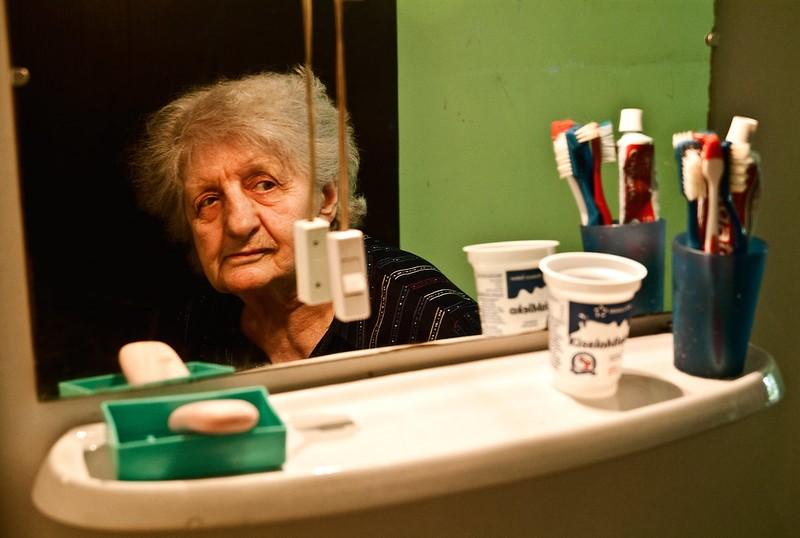Older age, male sex, and physical and cognitive impairments were linked to higher death rates from any cause in 5,256 residents at 351 US nursing homes, according to a study published today in JAMA Internal Medicine.
Led by researchers at Brown University, the cohort study involved mining the electronic health records, daily infection logs, and minimum data sets of resident assessments from a large chain of nursing homes in 25 states from Mar 16 to Sep 15, 2020. By 30 days after their first positive COVID-19 test result, 1,129 of the 5,256 residents (21%) had died from any cause.
Looking beyond age, underlying illnesses
Residents aged 80 to 84 years were 1.46 times more likely to die by 30 days than those aged 75 to 79, while those aged 85 to 90 were 1.59 more likely and those 90 and older were 2.14 more likely.
Signs and symptoms that increased the chances of death included fever (odds ratio [OR], 1.66), shortness of breath (OR, 2.52), abnormally fast heartbeat (OR, 1.31), and low oxygen levels (OR, 2.05). However, relatively few residents had symptoms, with 50% having fever, 19% having low oxygen levels, 17% having a rapid heartbeat, and 11% having shortness of breath.
Compared with residents with unimpaired cognition, those with moderate cognitive impairment were 2.09 times more likely to die, and those with severe impairment were 2.79 times more likely. Similarly, residents with moderate physical impairment were 1.49 times more likely to die than those with no or limited impairment, and those with severe physical limitations were 1.64 times more likely.
The researchers noted that people with advanced dementia often have trouble swallowing food, which can put them at increased risk from malnutrition, aspiration, bacterial pneumonia, and delirium. These patients also typically need help with bathing and feeding, which requires close contact with staff members, who may be infected and have high viral loads of pathogens such as COVID-19 but no symptoms.
Women were less likely than men to die (OR, 0.69), and those with diabetes and/or chronic kidney disease were more likely than their peers to die (OR, 1.21 and 1.33, respectively). Blacks and other racial minorities had a lower chance of dying than whites (OR, 0.77, vs 0.60).
Of the 5,256 residents who tested positive for COVID-19, 61% were women, 71% were white, 17% were black, and 11% were of other races. Median age was 79 years.
The authors said that understanding the factors that put nursing home residents with COVID-19 at elevated risk of death can help researchers create clinical risk-prediction models for death in long-term care settings.
"Once infected, those with baseline functional limitations, cognitive impairment, and disease severity are at heightened risk for mortality, with these impairments playing an important role in differentiating which patients are at higher and lower risk beyond what can be established based on age and comorbidities," they concluded. "These findings can be used to aid in prognostication and risk stratification in this population to inform treatment decisions and conversations around goals of care."
Promoting evaluation of cognitive, physical function
In a commentary in the same journal, Marlon Juliano Romero Aliberti, MD, PhD, and Thiago Junqueira Avelino-Silva, MD, PhD, of the University of Sao Paulo in Brazil, said that the prognostic factors identified in the study are more likely than COVID-19 tests, which are not always readily available in nursing homes, to be of immediate use in risk stratification.
Likewise, as shown in those in this study, older people often have no or few characteristic COVID-19 symptoms, which may delay or preclude accurate diagnosis, they said.
"It is time that we recognize that age alone does not sufficiently explain how older persons respond to COVID-19," they wrote. "Moreover, we should acknowledge the importance of going beyond traditionally assessed mortality risk factors and promote the evaluation of cognitive and physical functioning."
Aliberti and Avelino-Silva called for future studies of other age-related prognostic factors in nursing home patients with COVID-19, such as malnutrition, sensory deficits, depressive symptoms, and multiple prescriptions. "Above all, in a time of so much divisiveness and insecurity, we must not make a bad situation worse by succumbing to ageism when measuring prognosis in nursing home residents with COVID-19," they said.




















